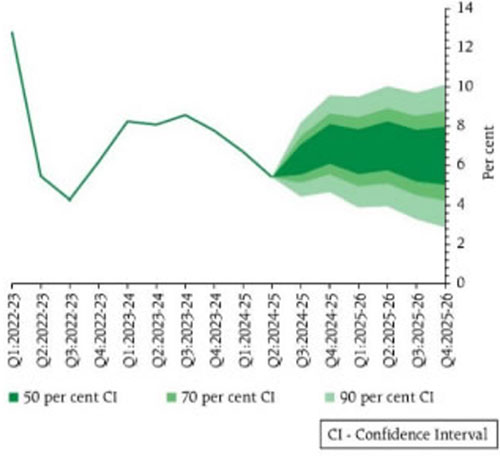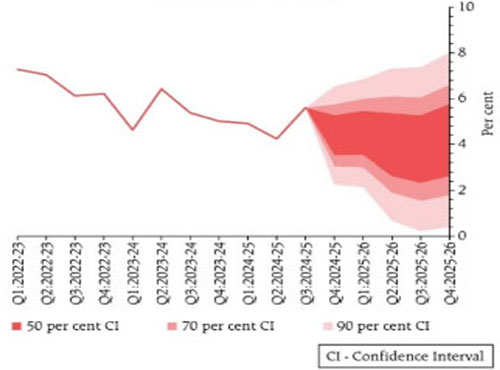RBI Cuts Repo Rate By 25 Basis Points to 6.25%. Here’s All You Need to Know
Rounaq Neroy
Feb 07, 2025 / Reading Time: Approx. 10 mins
Listen to RBI Cuts Repo Rate By 25 Basis Points to 6.25%. Here’s All You Need to Know
00:00
00:00
After keeping the policy repo rate unchanged for eleven successive meetings, the Reserve Bank of India (RBI), under its new Governor, Mr Sanjay Malhotra, cut the policy repo rate from 6.50% to 6.25%, i.e. by 25 basis points in monetary policy review meeting held between February 5 and 7, 2025.
The stance of the monetary policy is kept 'neutral' to remain unambiguously focussed on a durable alignment of inflation with the target while supporting growth.
Consequently, the Standing Deposit Facility (SDF) rate stood adjusted to 6.00% and the Marginal Standing Facility (MSF) rate and the Bank Rate to 6.50%.
The Cash Reserve Ratio (CRR) was maintained at 4.00% after a 50 bps reduction in the December 2024 meeting, which addressed liquidity in the system.
It is the first time in almost five years that the MPC has cut rates. All six members of the Monetary Policy Committee, RBI Governor Mr Sanjay Malhotra, Dr. Nagesh Kumar, Shri Saugata Bhattacharya, Prof. Ram Singh, Dr. Rajiv Ranjan, and Mr M. Rajeshwar Rao, unanimously took these decisions assessing the current and evolving macroeconomic situation.
These decisions are in consonance with the objective of achieving the medium-term target for Consumer Price Index (CPI) inflation of 4.00% within a band of +/-2.00%, while supporting growth.
The MPC observed that the global economy is growing below the historical average even though high-frequency indicators suggest resilience.
Besides, the world economic landscape remains challenging with a slower pace of disinflation, lingering geopolitical tensions and policy uncertainties. The strong dollar, inter alia, continues to strain emerging market currencies and enhance volatility in financial markets.
On the domestic front, as per the first advance estimates, the real GDP is expected to grow 6.4% in 2024-25 on the back of some recovery in private consumption. On the supply side, the services sector and recovery in agriculture are expected to support growth, but industrial growth is tepid and a drag.
Graph 1: RBI's Quarterly Projection of Real GDP Growth for India
 (Source: Monetary Policy Statement, 2024-25, February 5 to 7, 2025)
(Source: Monetary Policy Statement, 2024-25, February 5 to 7, 2025)
Going ahead, the RBI expects that the recovery in industrial activity and healthy rabi prospects should support growth in the fiscal year 2025-26. The following are seen as drivers of growth by the RBI:
-
Household consumption aided by the tax relief in the Union Budget 2025-26.
-
Recovery in fixed investments -- supported by higher capacity utilisation levels, healthy balance sheets of financial institutions and corporates, and the government's continued emphasis on capital expenditure
-
Resilient services exports
That being said, the central bank is also conscious of the fact that headwinds from geopolitical tensions, protectionist trade policies, volatility in international commodity prices and financial market uncertainties, continue to pose downside risks to the outlook.
Taking all these factors into consideration, real GDP growth for 2025-26 is projected by the RBI at 6.7% with Q1 at 6.7%; Q2 at 7.0%; and Q3 and Q4 at 6.5% each. The risks are evenly balanced.
Graph 2: RBI's Quarterly Projection of CPI
 (Source: Monetary Policy Statement, 2024-25, February 5 to 7, 2025)
(Source: Monetary Policy Statement, 2024-25, February 5 to 7, 2025)
As regards the CPI inflation, the MPC has noted that it declined or softened for two straight months November 2024 and December 2024, from the recent peak of 6.2% in October 2024. This is due to the moderation in food inflation, particularly the prices of vegetables. Plus, core inflation -- which excludes food and fuel -- also remained subdued.
Path to Interest Rates
The new RBI Governor Mr Sanjay Malhotra in the concluding remarks of his statement said:
"Considering the existing growth-inflation dynamics, the MPC, while continuing with the neutral stance, felt that a less restrictive monetary policy is more appropriate at the current juncture. The MPC will take a decision in each of its future meetings based on a fresh assessment of the macroeconomic outlook.
We are committed to conduct monetary policy and take such measures, as appropriate, which are timely, carefully calibrated and clearly communicated, to facilitate conducive macroeconomic conditions that reinforce price stability, sustained economic growth and financial stability "
Previously, when Mr Malhotra took charge (on December 11, 2024) he had said, "Stability in policy and continuity is very important. Decisions will be taken with public interest to preserve trust in this institution."
Well, much depends on the CPI inflation trajectory as regards policy rates are concerned.
The central bank has observed that excessive volatility in global financial markets and continued uncertainties about global trade policies coupled with adverse weather events pose risks to the growth and inflation outlook. Therefore, the MPC has decided to remain watchful.
If CPI inflation softens further and remains within the RBI's target range, the RBI may cut the policy rates further to support growth, which will be a decisive turn in the interest rate cycle.
On the other hand, if the headline inflation readings are above the target range, the RBI may be restrained from cutting rates.
Impact on the Indian Equity Market
The 25 bps rate cut by the RBI hasn't excited the Indian equity market. Perhaps the expectation was of a much deeper -- maybe 50 bps - cut by the RBI.
That being certain interest rate-sensitive sectors and consumption stocks would benefit from RBI policy rate cuts and the government exempting annual income up to Rs 12 lakh.
[Read: Top 5 Mutual Funds with Strong Holdings in India's Consumption Sector]
What Should be Your Investment Strategy to Invest in Debt Mutual Funds Now?
At the current juncture, it would be an opportune time to invest in Medium-to-Long Duration Debt Mutual Funds, wherein the maturity profile of these funds should be up to 5 years or so with G-secs around 30%. When investing in these funds, keep an investment horizon of 3 to 5 years whereby you benefit from higher yield and unlock the capital growth. However, it is best to invest in these funds in a staggered manner.
For an investment horizon of 2 to 3 years, you may consider investing in some of the best Banking & PSU Debt Funds. At present, around 30% of your debt mutual fund portfolio could be allocated to some of the best Banking & PSU Debt Funds.
[Read: Best Mutual Funds for Short Term Investments]
Keep in mind that investing in debt mutual funds, in general, is not risk-free, and hence choose the safety of the principal over returns. Avoid investing in debt funds that engage in yield hunting to clock higher returns.
If you have an investment horizon of a few months or up to a year, it would be better to stick to some of the best Liquid Funds having the least or no exposure to private issuers.
Invest Strategy to Invest in Bank Fixed Deposits
Before we see the transmission of the policy rate cut and the banks cut their fixed deposit rates, it would be sensible to invest in bank fixed deposits. Senior citizens can benefit from an additional 0.50% interest rate on bank FDs.
Exercise caution when considering banks offering significantly higher interest rates than the market average, as higher returns often come with higher risks. It would be prudent to diversify your investment in FDs across banks rather than keeping money in only one or two. This helps to mitigate the risk.
Note that deposits of up to Rs 5 lakhs are insured by the Deposit Insurance and Credit Guarantee Corporation (DICGC), per bank per depositor. By diversifying, you can ensure all your deposits fall within the insured limit, minimising risk.
To make the most of your investment and maintain liquidity, Fixed Deposit laddering is a smart strategy. It involves spreading your FD investments across multiple maturity tenures or maturity buckets (e.g. 6 months, 1 year, 2 years) rather than locking all your funds in a single FD. With this approach, you can potentially secure higher returns while ensuring liquidity to cover emergency expenses, without needing to prematurely break long-term deposits.
In the current scenario, it is prudent to opt for shorter tenures - preferably not more than 2 years. FDs with tenures of 6 months, 1 year, or 2 years provide a meaningful balance of returns, liquidity, and flexibility as per your needs.
If you need access to money during emergencies, choose short-term deposits (of 12 to 18 months tenure).
To Conclude...
With the RBI cutting the repo rate by 25 basis, make sure you are investing sensibly - whether it is equity mutual funds, debt mutual funds, and/or bank fixed deposits.
Following a thoughtful approach and devising an investment strategy, shall potentially bring your financial success and security.
Make investments that align with your risk profile, investment objective, financial goals, investment horizon, and liquidity needs.
Happy investing!
We are on Telegram! Join thousands of like-minded investors and our editors right now.
-New.png)
ROUNAQ NEROY heads the content activity at PersonalFN and is the Chief Editor of PersonalFN’s newsletter, The Daily Wealth Letter.
As the co-editor of premium services, viz. Investment Ideas Note, the Multi-Asset Corner Report, and the Retire Rich Report; Rounaq brings forth potentially the best investment ideas and opportunities to help investors plan for a happy and blissful financial future.
He has also authored and been the voice of PersonalFN’s e-learning course -- which aims at helping investors become their own financial planners. Besides, he actively contributes to a variety of issues of Money Simplified, PersonalFN’s e-guides in the endeavour and passion to educate investors.
He is a post-graduate in commerce (M. Com), with an MBA in Finance, and a gold medallist in Certificate Programme in Capital Market (from BSE Training Institute in association with JBIMS). Rounaq holds over 18+ years of experience in the financial services industry.
Disclaimer: Investment in securities market are subject to market risks, read all the related documents carefully before investing.
This article is for information purposes only and is not meant to influence your investment decisions. It should not be treated as a mutual fund recommendation or advice to make an investment decision in the above-mentioned schemes.